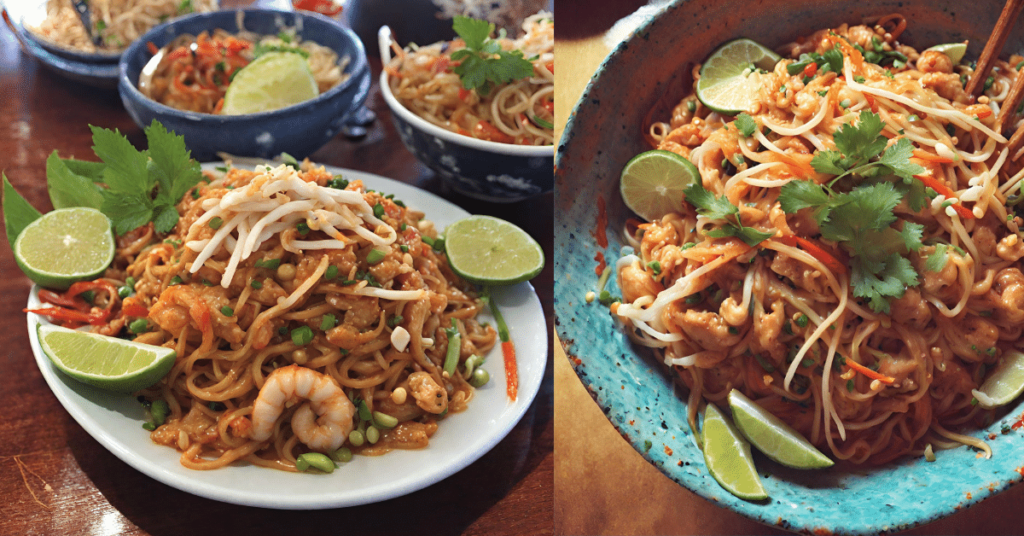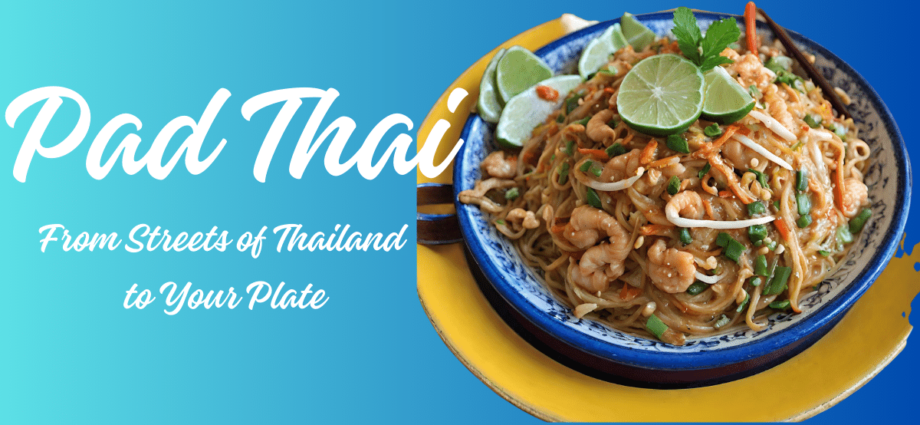Introduction
Welcome to a flavorful expedition into the heart of Thai cuisine! Pad Thai, a beloved Thai street food classic, has transcended its origins to become a global sensation.
In this blog, we’ll trace the roots of Pad Thai, explore its fascinating history, celebrate its vibrant palate, and even guide you through crafting this delectable dish in your own kitchen.
Unveiling the Origins of Pad Thai
To understand Pad Thai, we must first immerse ourselves in its history. This iconic dish’s origins are believed to be a blend of cultural influences shaped by Thailand’s diverse culinary landscape.
Though the exact timeline is debated, Pad Thai gained prominence during the mid-20th century and was actively promoted as a national dish by the Thai government.
Pad Thai’s history is a culinary tapestry woven with influences from various cultures, creating a dish that is uniquely Thai.
Its origins are believed to date back to the 1930s or 1940s during a time of culinary reform in Thailand.
Here are some key historical insights into the dish:
- Cultural Influences: Pad Thai’s creation was influenced by the Thai government’s efforts to promote a sense of national identity and unify the country. Thai leaders sought to reduce rice consumption, which was heavily influenced by Chinese culture, and introduce wheat-based noodles.
- Wartime Rationing: During World War II, Thailand experienced rice shortages due to the war’s impact on rice production. To address this, the Thai government actively promoted the use of wheat noodles, which led to the popularization of Pad Thai as a national dish.
- Ingredient Adaptations: Traditional Pad Thai typically includes shrimp, tofu, or chicken, but it has evolved to accommodate a wide range of proteins and dietary preferences. The use of tamarind for a tangy flavor and fish sauce for saltiness reflects the local Thai palate.
- Global Recognition: Pad Thai’s versatility and deliciousness quickly gained popularity both within and beyond Thailand. It became a symbol of Thai cuisine on the international stage, showcasing the balance of sweet, savory, spicy, and sour flavors that Thai food is renowned for.
Pad Thai’s Palette: A Symphony of Flavors
One of the reasons Pad Thai has captured hearts worldwide is its remarkable balance of flavors.
This dish harmoniously combines sweet, savory, spicy, and sour elements, creating a palate that dances on your taste buds.
The key components include:
- Rice Noodles: Providing a soft and chewy base.
- Protein: Often shrimp, chicken, or tofu, adding depth and texture.
- Tamarind: Offering a tart and slightly sweet tang.
- Fish Sauce: Delivering saltiness and depth.
- Palm Sugar: Infusing subtle sweetness.
- Crushed Peanuts: Adding a delightful crunch.
- Lime: Offering a fresh, citrusy zing.
- Bean Sprouts: Providing a crisp, refreshing contrast.
- Chili: For a touch of heat (adjustable to your preference).
- Cilantro: As a fragrant garnish.

Crafting Pad Thai: A Culinary Adventure
Now, let’s embark on the exciting journey of preparing Pad Thai in your own kitchen. Follow these steps for an authentic and mouthwatering experience:
Ingredients:
- 8 oz (about 225g) rice noodles
- 1/2 cup protein of your choice (shrimp, chicken, or tofu), thinly sliced
- 2 cloves garlic, minced
- 2 eggs, lightly beaten
- 2 tablespoons vegetable oil
- 2 tablespoons tamarind paste
- 1 tablespoon fish sauce
- 1 tablespoon palm sugar (or brown sugar)
- 1/4 cup crushed peanuts
- Lime wedges, bean sprouts, and cilantro for garnish
Instructions:
- Prepare Rice Noodles: Soak rice noodles in warm water for about 20-30 minutes until they become pliable but not mushy. Drain and set aside.
- Create Sauce: In a bowl, mix tamarind paste, fish sauce, and palm sugar to create the Pad Thai sauce.
- Cook Protein: Heat oil in a wok or large skillet over medium-high heat. Add minced garlic and your choice of protein. Cook until the protein is cooked through.
- Add Noodles and Sauce: Push the protein to one side of the pan and add the beaten eggs to the other side. Scramble the eggs until they’re almost set, then add the drained rice noodles.
- Pour in Sauce: Pour the prepared Pad Thai sauce over the noodles and toss everything together. Stir-fry for a few minutes until the noodles absorb the flavors.
- Add Crushed Peanuts: Sprinkle crushed peanuts over the noodles and continue stir-frying until everything is well combined and heated through.
- Garnish and Serve: Serve your Pad Thai hot, garnished with lime wedges, bean sprouts, and cilantro.
You Might Also Be Interested: Exploring the Flavorful Chicken Adobo: A Filipino Classic
Conclusion: Savor the Magic of Pad Thai
Pad Thai is more than just a dish; it’s a sensory journey through Thai culture and flavors.
From its humble beginnings on the streets of Thailand to its global popularity today, Pad Thai’s allure is undeniable.
So, gather your ingredients, embark on this culinary adventure, and savor the magic of Pad Thai in your own home. Enjoy!
You Might Also Like:
Crispy Fried Chicken Delight: A Filipino Favorite
Chicken Tikka Masala: A British Culinary Icon with an International Twist
Paksiw na Bangus: A Flavorful Filipino Classic
Exploring the Savory Delight of Bulalo: Origin, Flavor, and Recipe
7 Must-Try Bites for Your Singaporean Food Adventure
Savory Delight: Journey into Filipino Cuisine with Balbacua
- Top Digital Nomad Cities in Latin America (2026 Edition) - 15 December 2025
- Top Digital Nomad Cities in Europe (2026 Edition) - 14 December 2025
- Top Digital Nomad Cities in Asia (2026 Edition) - 14 December 2025











